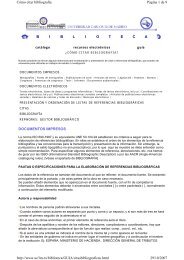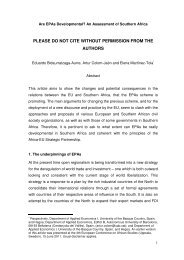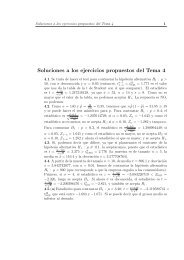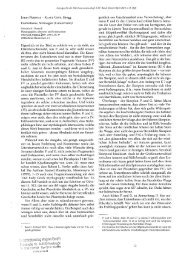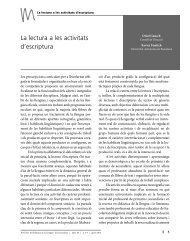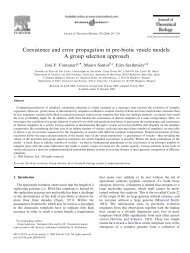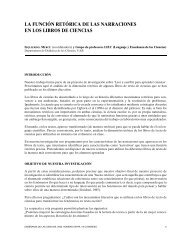Proceedings of the 6th St. Petersburg Workshop on Simulation, June ...
Proceedings of the 6th St. Petersburg Workshop on Simulation, June ...
Proceedings of the 6th St. Petersburg Workshop on Simulation, June ...
Create successful ePaper yourself
Turn your PDF publications into a flip-book with our unique Google optimized e-Paper software.
83848586878889909192939495Roughly speaking, state space collapse assumpti<strong>on</strong> expresses that any fluidclass k c<strong>on</strong>tributes a fixed porti<strong>on</strong> δ k to <str<strong>on</strong>g>the</str<strong>on</strong>g> workload at stati<strong>on</strong> s(k). That is, <str<strong>on</strong>g>the</str<strong>on</strong>g>fluid classes processed at <str<strong>on</strong>g>the</str<strong>on</strong>g> same stati<strong>on</strong> are mixed in a fixed way in <str<strong>on</strong>g>the</str<strong>on</strong>g> stati<strong>on</strong>’squeue.Remark 1. In <str<strong>on</strong>g>the</str<strong>on</strong>g> particular case K = J, if we assume for c<strong>on</strong>venience (andwithout loss <str<strong>on</strong>g>of</str<strong>on</strong>g> generality) that s(j) = j for any j = 1, . . . , J, <str<strong>on</strong>g>the</str<strong>on</strong>g>n C = I, (7)becomes W = M Z and we trivially obtain state space collapse with regular “lifting”matrix ∆ = M −1 .Now we establish our main result. Recall that we assume ρ < e .Theorem 1. The fluid limit model is stable if verifies state space collapse with aregular “lifting” matrix ∆.The pro<str<strong>on</strong>g>of</str<strong>on</strong>g> <str<strong>on</strong>g>of</str<strong>on</strong>g> <str<strong>on</strong>g>the</str<strong>on</strong>g> <str<strong>on</strong>g>the</str<strong>on</strong>g>orem is based <strong>on</strong> two lemmas formulated below. For <str<strong>on</strong>g>the</str<strong>on</strong>g>sake <str<strong>on</strong>g>of</str<strong>on</strong>g> completeness we introduce a known definiti<strong>on</strong>:Definiti<strong>on</strong> 3 (R-regularizati<strong>on</strong> or Skorokhod problem). Let ˜X be a J−dim.stochastic process with c<strong>on</strong>tinuous paths, defined <strong>on</strong> some probability space, with˜X(0) ≥ 0 , and ˜R a J ×J matrix. We say that <str<strong>on</strong>g>the</str<strong>on</strong>g> pair ( ˜W , Ỹ ) <str<strong>on</strong>g>of</str<strong>on</strong>g> J−dim. stochasticprocesses defined <strong>on</strong> <str<strong>on</strong>g>the</str<strong>on</strong>g> same probability space and with c<strong>on</strong>tinuous paths is asoluti<strong>on</strong> <str<strong>on</strong>g>of</str<strong>on</strong>g> <str<strong>on</strong>g>the</str<strong>on</strong>g> ˜R−Skorokhod problem <str<strong>on</strong>g>of</str<strong>on</strong>g> ˜X in <str<strong>on</strong>g>the</str<strong>on</strong>g> first orthant RJ+ if:˜W (t) ∈ R J + for all t ≥ 0 , ˜W = ˜X + ˜R Ỹ a.s.Ỹ has n<strong>on</strong> − decreasing paths , Ỹ (0) = 0 and for any j, Ỹ j <strong>on</strong>ly increasesif ˜W is <strong>on</strong> face {w ∈ RJ+ : w j = 0} , that is ,∫ ∞0˜W j (t) d Ỹj(t) = 0 .9697Remark 2. Propositi<strong>on</strong> 4.2 [6] shows that c<strong>on</strong>diti<strong>on</strong> (HR) <strong>on</strong> a matrix ˜R issufficient to ensure str<strong>on</strong>g path-wise uniqueness <str<strong>on</strong>g>of</str<strong>on</strong>g> <str<strong>on</strong>g>the</str<strong>on</strong>g> soluti<strong>on</strong>.Lemma 1 (Lemma 5.1 [2]). Assume ρ < e. Let ( ˜W , Ỹ ) be <str<strong>on</strong>g>the</str<strong>on</strong>g> (unique) soluti<strong>on</strong><str<strong>on</strong>g>of</str<strong>on</strong>g> <str<strong>on</strong>g>the</str<strong>on</strong>g> ˜R−Skorokhod problem <strong>on</strong> <str<strong>on</strong>g>the</str<strong>on</strong>g> first orthant <str<strong>on</strong>g>of</str<strong>on</strong>g> a process ˜X, with ˜R verifyingassumpti<strong>on</strong> (HR). If˜W (s) + ˜X(t + s) − ˜X(s) ≥ θ t for all s, t ≥ 0 ,with θ = ˜R 98 (ρ−e), <str<strong>on</strong>g>the</str<strong>on</strong>g>n we have that Ỹ (t+s)−Ỹ (s) ≤ (e−ρ) t for all s, t ≥ 0 , andhence Ỹ ′ (s) ≤ (e − ρ) if Ỹ (·) is differentiable at s and Ỹ ′ 99(·) denotes its derivative.100101102103Lemma 2 (Lemma 5.2 [2]). Let f : [0, +∞) −→ [0, +∞) be a n<strong>on</strong>negativefuncti<strong>on</strong> that is absolutely c<strong>on</strong>tinuous and let κ > 0 be a c<strong>on</strong>stant. Suppose thatfor almost surely (with respect to <str<strong>on</strong>g>the</str<strong>on</strong>g> Lebesgue measure <strong>on</strong> [0, +∞) ) all regularpoints t, f ′ (t) ≤ −κ whenever f(t) > 0. Then f is n<strong>on</strong>increasing and f(t) ≡ 0 fort ≥ f(0)104 κ .Pro<str<strong>on</strong>g>of</str<strong>on</strong>g> <str<strong>on</strong>g>of</str<strong>on</strong>g> Theorem 1: C<strong>on</strong>sider a fluid limit model (α, M, C, P, z) with ρ < e105106and satisfying state space collapse with a regular “lifting” matrix ∆. We want to4
107108prove <str<strong>on</strong>g>the</str<strong>on</strong>g> existence <str<strong>on</strong>g>of</str<strong>on</strong>g> some t 0 > 0 such that for any soluti<strong>on</strong> <str<strong>on</strong>g>of</str<strong>on</strong>g> <str<strong>on</strong>g>the</str<strong>on</strong>g> fluid modelequati<strong>on</strong>s, Ψ(·) = ( A(·), D(·), T (·), Z(·), W (·), Y (·) ) , Z(t) = 0 ∀t ≥ t 0 |z| .<str<strong>on</strong>g>St</str<strong>on</strong>g>ep 1: We will see that (W, Y ) is <str<strong>on</strong>g>the</str<strong>on</strong>g> unique soluti<strong>on</strong> <str<strong>on</strong>g>of</str<strong>on</strong>g> <str<strong>on</strong>g>the</str<strong>on</strong>g> R−Skorokhodproblem <str<strong>on</strong>g>of</str<strong>on</strong>g> X <strong>on</strong> <str<strong>on</strong>g>the</str<strong>on</strong>g> first orthant, X being defined by X(t) def= W (0) + θ t , andR = (C M Q ∆) −1 . Indeed, from (2) we obtain D(t) = z + A(t) − Z(t) , which canbe substituted in (1) givingA(t) = Q α t + Q P T z − Q P T Z(t) . (8)By state space collapse assumpti<strong>on</strong> with regular “lifting” matrix ∆, we can replacein (8) Z by ∆ W , and by substituting into (6) obtainW (t) = W (0) + C M ( Q α t + Q P T ∆ W (0) − Q P T ∆ W (t) ) − e t + Y (t) ,by using (4) and <str<strong>on</strong>g>the</str<strong>on</strong>g> fact that W (0) = C M z. By isolating W (t) in its turnfrom this expressi<strong>on</strong> and taking into account <str<strong>on</strong>g>the</str<strong>on</strong>g> definiti<strong>on</strong> <str<strong>on</strong>g>of</str<strong>on</strong>g> R and <str<strong>on</strong>g>the</str<strong>on</strong>g> fact thatI + C M Q P T ∆ = C M Q ∆, and that ρ = C M Q α , we finally have thatW (t) = W (0) + R (ρ − e) t + R Y (t) . (9)If we denote R (ρ − e) by θ as in Lemma 1, we have by (9) and (5) that (W, Y )is a soluti<strong>on</strong> <str<strong>on</strong>g>of</str<strong>on</strong>g> <str<strong>on</strong>g>the</str<strong>on</strong>g> R−Skorokhod problem <str<strong>on</strong>g>of</str<strong>on</strong>g> X <strong>on</strong> <str<strong>on</strong>g>the</str<strong>on</strong>g> first orthant. Assumpti<strong>on</strong>(HR) <strong>on</strong> matrix R given by <str<strong>on</strong>g>the</str<strong>on</strong>g> regularity <str<strong>on</strong>g>of</str<strong>on</strong>g> ∆, ensures <str<strong>on</strong>g>the</str<strong>on</strong>g> uniqueness <str<strong>on</strong>g>of</str<strong>on</strong>g> <str<strong>on</strong>g>the</str<strong>on</strong>g>soluti<strong>on</strong>. Therefore we can apply Lemma 1 becausewhich is easy to check sinceW (s) + X(t + s) − X(s) ≥ θ t for all s, t ≥ 0 ,W (s) + X(t + s) − X(s) = W (s) + (W (0) + θ (t + s)) − (W (0) + θ s) = W (s) + θ t ,and W ≥ 0 . As a c<strong>on</strong>sequence, if Y is differentiable at point s,<str<strong>on</strong>g>St</str<strong>on</strong>g>ep 2: Take <str<strong>on</strong>g>the</str<strong>on</strong>g> Lyapunov functi<strong>on</strong>Y ′ (s) ≤ e − ρ . (10)g(t) = e T R −1 W (t) , (11)to which we will apply Lemma 2. By substituting (9) into (11),g(t) = e T R −1 W (0) + e T (ρ − e) t + e T Y (t) = g(0) +J∑ ((ρj − 1) t + Y j (t) ) .Then, <str<strong>on</strong>g>the</str<strong>on</strong>g> points <str<strong>on</strong>g>of</str<strong>on</strong>g> differentiability <str<strong>on</strong>g>of</str<strong>on</strong>g> Y j (·) coincide with those <str<strong>on</strong>g>of</str<strong>on</strong>g> g(·), and if t is<strong>on</strong>e <str<strong>on</strong>g>of</str<strong>on</strong>g> <str<strong>on</strong>g>the</str<strong>on</strong>g>se points,g ′ (t) =J∑j=1j=1((ρj − 1) + Y ′j (t) ) , (12)5





